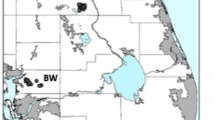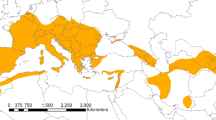Abstract
The forest batis, Batis mixta, is a common bird of the forests of the Eastern Arc Mountains of Tanzania and in some adjacent montane and coastal forests. Through new collecting efforts in most of this range we documented a well-marked change in morphology in the middle of the range. Supplementary genetic studies of the historical population structure suggest connectivity among the south-western and northern/coastal populations, but not between these parapatric groups. It is concluded that two species are involved, and a new name B. crypta is proposed for the south-western populations. A marked genetic break also exists towards B. capensis sola in northern Malawi. The morphologically distinctive form reichenowi in south-eastern Tanzania is genetically nested within B. mixta, and for now we keep it as a subspecies of B. mixta.





Similar content being viewed by others
References
Baker N, Baker E (2002) Important Bird Areas in Tanzania. Wildlife Conservation Society of Tanzania, Dar es Salaam
Bowie RCK (2003) Birds, molecules and evolutionary patterns among Africa’s islands in the sky. Unpublished PhD thesis, University of Cape Town
Bowie RCK, Fjeldså J, Hackett SJ, Crowe TM (2004a) Systematics and biogeography of Double-Collared Sunbirds from the Eastern Arc Mountains, Tanzania. Auk 121:660–681
Bowie RCK, Fjeldså J, Hackett SJ, Crowe TM (2004b) Molecular evolution in space and though time: mtDNA phylogeography of the Olive Sunbird (Nectarinia olivacea/obscura) throughout continental Africa. Mol Phylogenet Evol 33:56–76
Bowie RCK, Voelker G, Fjeldså J, Lens L, Hackett SJ, Crowe TM (2005) Systematics of the Olive Thrush Turdus olivaceus species complex with reference to the taxonomic status of the endangered Taita Thrush T. helleri. J Avian Biol 36:391–404
Bowie RCK, Fjeldså J, Hackett SJ, Bates JM, Crowe TM (2006) Coalescent models reveal the relative roles of ancestral polymorphism, vicariance and dispersal in shaping phylogeographical structure of an African montane forest robin. Mol. Phylogenet. Evol 38:171–188
Britton PL (1980) Birds of East Africa. East African Natural History Society, Nairobi
Burgess ND, Mlingwa COF (2000) Evidence for altitudinal migration of forest birds between montane Eastern Arc and lowland forests in East Africa. Ostrich 71:184–190
Burgess ND, Cordeiro N, Doggart N, Fjeldså J, Hansen LA, Howell K, Kilahama F, Lovett JC, Menegon M, Moyer D, Nashanda E, Perkin A, Stanley W, Stuart S (2006) The biological importance of the Eastern Arc Mountains of Tanzania. Biol Conserv (in press)
Clement M, Posada D, Crandall KA (2000) TCS: a computer program to estimate gene genealogies. Mol Ecol 9:1657–1660
Cracraft J (1997) Species concepts in systematics and conservation biology: an ornithological viewpoint. In: Claridge MF, Daway HA, Wilson MR (eds) Species: the units of biodiversity. Chapman & Hall, London, pp 325–339
Dickinson EC (2003) The Howard and Moore complete checklist of the birds of the world, 3rd edn. Princeton University Press, Princeton
Dowsett RJ, Dowsett-Lemaire F (1980) The systematic status of some Zambian birds. Gerfaut 70:151–199
Dowsett RJ, Dowsett-Lemaire F (1993) A contribution to the distribution and taxonomy of Afrotropical and Malagasy birds. Tauraco Press, Liège
Dowsett-Lemaire F (1989) Ecological and biogeographical aspects of forest bird communities in Malawi. Scopus 13:1–80
Fjeldså J, Lovett J (1997) Geographical patterns of old and young species in African forest biota: the significance of specific montane areas as evolutionary centers. Biodiver Conserv 6:325–347
Fuchs J, Bowie RCK, Fjeldså J, Pasquet E (2004) Phylogenetic relationships of the African bush-shrikes and helmet-shrikes (Passeriformes: Malaconotidae). Mol Phylogenet Evol 33:428–439
Grote H (1911) Neue Vogelarten aus Ostafrika. Orn Monatsber 19:162–163
Harris T, Arnott G (1988) The shrikes of southern Africa. Struik, Cape Town
Harris T, Franklin K (2000) Shrikes and bush-shrikes. Including wood-shrikes, helmet-shrikes, flycatcher-shrikes, philentomas, batises and wattle-eyes. Helm, London
Jetz W, Rahbek C, Colwell RK (2004) The coincidence of rarity and richness and the potential signature of history in centers of endemism. Ecol Lett 7:1180–1191
Lawson WJ (1962) Geographic variation in Woodward’s Batis Batis fratrum (Shelley). Durban Mus Novit 6:220–224
Lawson WJ (1986) Speciation in the forest-dwelling populations of the avian genus Batis. Durban Mus Novit 13:285–304
Lovett JC, Wasser SK (1993) Biogeography and ecology of the rain forests of Eastern Africa. Cambridge University Press, Cambridge
Mundy NI, Badcock NS, Hart T, Scribner K, Janssen K, Nadeau NJ (2004) Conserved genetic basis of a quantitative plumage trait involved in mate choice. Science 303:1870–1873
Posada D, Crandall KA (2001) Intraspecific gene genealogies: tree grafting into cladograms. Trends Ecol Evol 16:37–45
Ricklefs RE, Latham RE (1993) Global patterns of diversity in mangrove floras. In: Ricklefs RE, Schluter D (eds) Species diversity in ecological communities. Historical and geographical perspectives. University of Chicago Press, Chicago, pp 215–229
Romdal TS (2001) Altitudinal distribution and abundance patterns of bird species in the Eastern Arc Mountains, Tan zania. Scopus 21:35–54
Ronquist F, Huelsenbeck JP (2003) MRBAYES 3: Bayesian phylogenetic inference under mixed models. Bioinformatics 19:1572–1574
Sinclair I, Ryan P (2003) Birds of Africa south of the Sahara. A comprehensive illustrated field guide. Struik, Cape Town
Stevenson T, Fanshawe J (2002) Field guide to the birds of East Africa. Poyser, London
Swofford DL (2002) PAUP*: phylogeny analysis using parsimony (*and other methods), version 4.0b 10. Sinauer, Sutherland
Traylor MA (1986) The Platysteiridae, Puffback Flycatchers. In: Mayr E, Cottrell GW (eds) Check-list of birds of the world, vol 11. Mus. Compar. Zool, Cambridge, pp 376–386
Urban EK, Fry CH, Keith S (1997) Birds of Africa: thrushes to puffback flycatchers, vol 5. Academic, London
Acknowledgments
We thank the Natural History Museum at Tring and the Field Museum for loan of specimens, and the curators in Bonn (R. van Elzen), Leiden (R. Dekker), Nairobi (M. Muchane), Paris (E. Pasquet) and Stockholm (P. Ericson, G. Frisk) for access to their collections. We also thank the Field Museum of Natural History, Museums of Malawi and the Marjorie Barrick Museum for loan of tissues. Fieldwork was supported by grants from the Danish Research Council to J.F. and from the Field Museum and Stellenbosch University to R.B. Laboratory work was supported by grants from the National Research Foundation (South Africa), Department of Science and Technology (South Africa) and Stellenbosch University to R.B. The research complies with current laws in the countries where the work was done. CapeNature is thanked for permission to collect specimens in South Africa and the Tanzanian Commission for Science and Technology and Wildlife Research Institute are thanked for permission to conduct fieldwork and to collect and export specimens. The collections from Tanzania are held in trust at the Zoological Museum, University of Copenhagen.
Author information
Authors and Affiliations
Corresponding author
Additional information
Communicated by F. Bairlein
Rights and permissions
About this article
Cite this article
Fjeldså, J., Bowie, R.C.K. & Kiure, J. The forest batis, Batis mixta, is two species: description of a new, narrowly distributed Batis species in the Eastern Arc biodiversity hotspot. J Ornithol 147, 578–590 (2006). https://doi.org/10.1007/s10336-006-0082-4
Received:
Revised:
Accepted:
Published:
Issue Date:
DOI: https://doi.org/10.1007/s10336-006-0082-4




